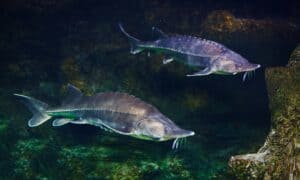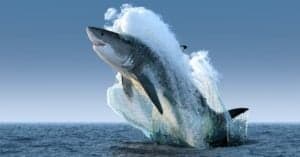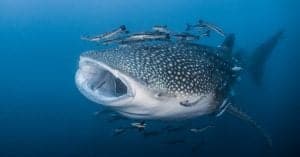Eagle Ray vs Manta Ray: What are the Differences?
@media (min-width: 481px) {
.mobile-top-content {
display: none;
}
}
#mobileTopContentCTACarouselControls { overflow: hidden; text-overflow: ellipsis; white-space: nowrap; }
.mobile-top-content .more { color: #fff; }
.mobile-top-content a { color: #fff; text-decoration: underline; }
.mobile-top-content a:hover { color: #fff; text-decoration: underline; }
@media (max-width: 480px) {
.mobile-top-content {
background-color: #06a10b;
color: #fff;
text-align: center;
/*height: 60px;
padding-top:5px;*/
font-size:80%;
/* display: block; */
margin: 0px -30px;
}
}
The eagle ray and manta ray are two of the most amazing aquatic creatures on the planet. They are a family of cartilaginous fish belonging to the Myliobatidae and Mobulidae families that live in the open ocean rather than on the seafloor.
About 12 species of flat, disk-shaped fish with wing-like pectoral fins make up the eagle ray family. These fishes live in warm tropical and temperate ocean and sea waters and have a widespread distribution. However, the manta Ray has had to deal with some genus changes. This species was originally classified as a part of the Manta genus and had the scientific name Manta birostris. Subsequently, Manta birostris and the reef manta ray, Manta alfredi, were both transferred to the Mobula genus because they are strongly linked to Mobula species.
It might be difficult to distinguish amongst the roughly 600 species of rays that exist. They have flat disk-shaped bodies and a long whip-like tail. These species also have mouths and gills on their stomachs and eyes on the tops of their heads. They can’t see their prey, so they rely on scent and electro-receptors like sharks.
Comparing the Eagle Ray vs the Manta Ray

A-Z-Animals.com
| Eagle Ray | Manta Ray | |
|---|---|---|
| Appearance | Disk-like shape, a long tail, and massive pectoral fins connected to their heads that resemble wings. | Large heads and triangular pectoral fins. Gill holes on their ventral surfaces and horn-shaped cephalic fins on both sides of the mouth. |
| Size | Length: Typically between 1.6 and 16.7 feet long, with wings up to 8 feet broad and a tail that can be up to 16 feet long. Weight: About 500 pounds. |
Length: Oceanic manta rays are usually about 13 feet but can reach 22 feet. Reef manta rays are generally about 10 feet. Weight: May weigh up to 4500 pounds. |
| Habitat | It can be found in warm coastal areas and estuaries throughout New Zealand and the Southwest Pacific. | Reef mantas can be found in shallow waters and coral reefs in moderate to tropical environments. Oceanic mantas live in warm tropical waters. |
| Diet | Majorly bottom feeders that eat oysters, snails, scallops, lobsters, worms, slugs, and hermit crabs, among other mollusks and crustaceans. | Filter feeders with forward-facing mouths that eat fish larvae and zooplanktons such as jellyfish, krill, shrimp, and conger eel. |
| Lifespan | Around 25 years. | Can live up to 40 years. |
The Key Differences Between Eagle Rays and Manta Rays
The key differences between eagle rays and manta rays are appearance, size, habitat, diet, and lifespan.
Let’s explore these differences in detail!
Eagle Ray vs Manta Ray: Appearance
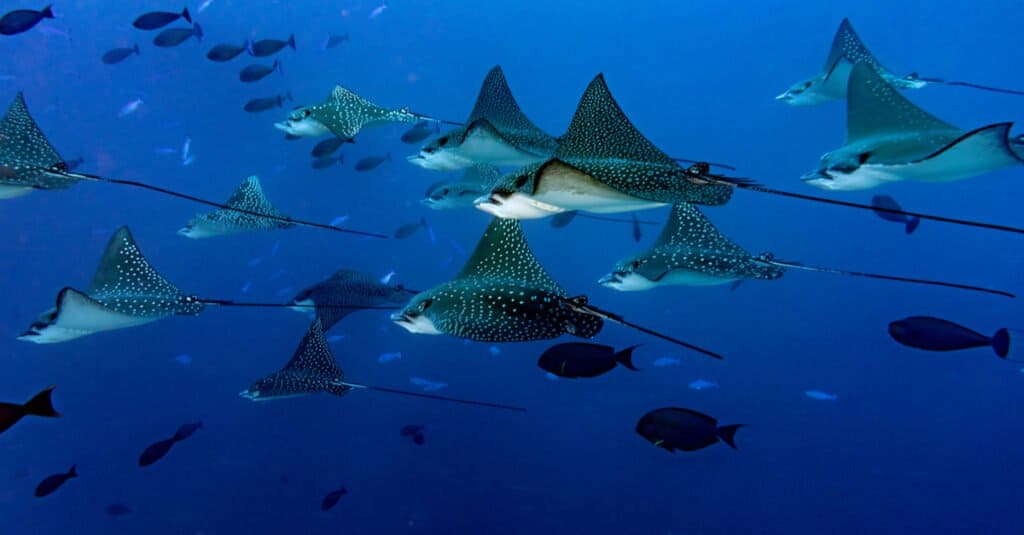
Andrea Izzotti/Shutterstock.com
All eagle rays have a disk-like shape, a long tail, and massive pectoral fins connected to their heads that resemble wings. The mouth and gill openings are on the ventral (lower) side, while the eyes, fins, and tail are on the dorsal (top) side. The barb on the base of the tail behind the pelvic fins is essentially a venomous stinger. Eagle rays can be black, blue, and dark grey.
On the other hand, manta rays have large heads and triangular pectoral fins. They also have gill holes on their ventral surfaces and horn-shaped cephalic fins on both sides of their mouth. Their bodies are horizontally flattened, and their eyes are located on the sides of their heads, behind the cephalic fins. They have no skeletal support, and their tails are shorter than their disc-like bodies. The dorsal fins are small and positioned near the tail’s tip.
Eagle Ray vs Manta Ray: Size
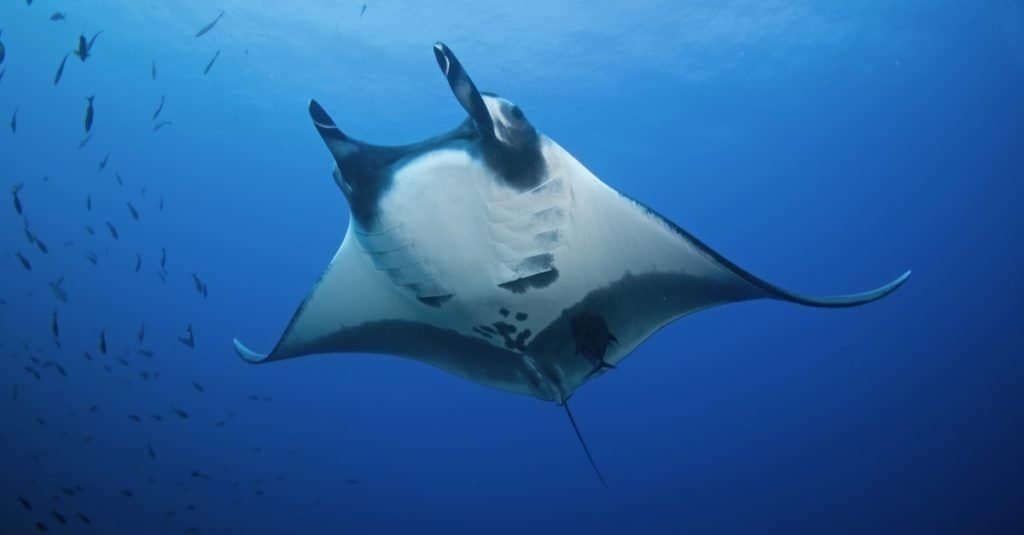
Martin Prochazkacz/Shutterstock.com
Spotted eagle rays can grow up to 16.4 feet in length and have a 10-foot wingspan. The disk’s tail measures 2.5 to 3 times its width. Other eagle rays can grow between 1.6 and 16.7 feet long, with wings up to 8 feet wide and a tail that can be up to 16 feet long. The weight of the animal is estimated to be around 500 pounds.
A fully mature oceanic manta ray’s wingspan can reach 22 feet from tip to tip of each wing, but most are 13 feet long. They are the largest ray species in the world. Reef manta rays are typically about 9 to 11 feet long, though lengths of up to 16 feet have been observed in the past. Manta rays can be up to 4,500 pounds in weight.
Eagle Ray vs Manta Ray: Habitat
Eagle rays can be found in coastal areas and estuaries throughout New Zealand and the Southwest Pacific, where they spend most of their time in shallow waters up to 160 m deep. They are mainly found in warm coastal areas, searching for food on the ocean floor. When they’re not hunting on the ocean floor, they’re typically seen drifting through the water column. They spend most of their time on sandy and swampy grounds, but they can also be found near reefs.
Meanwhile, manta rays spend their entire lives swimming up and down the ocean’s column. Reef manta rays can be found in shallow waters and coral reefs in moderate to tropical environments. Oceanic manta rays, however, live in warm tropical waters all over the planet, spending the greater part of their lives between the surface and 400 feet deep.
Eagle Ray vs Manta Ray: Diet
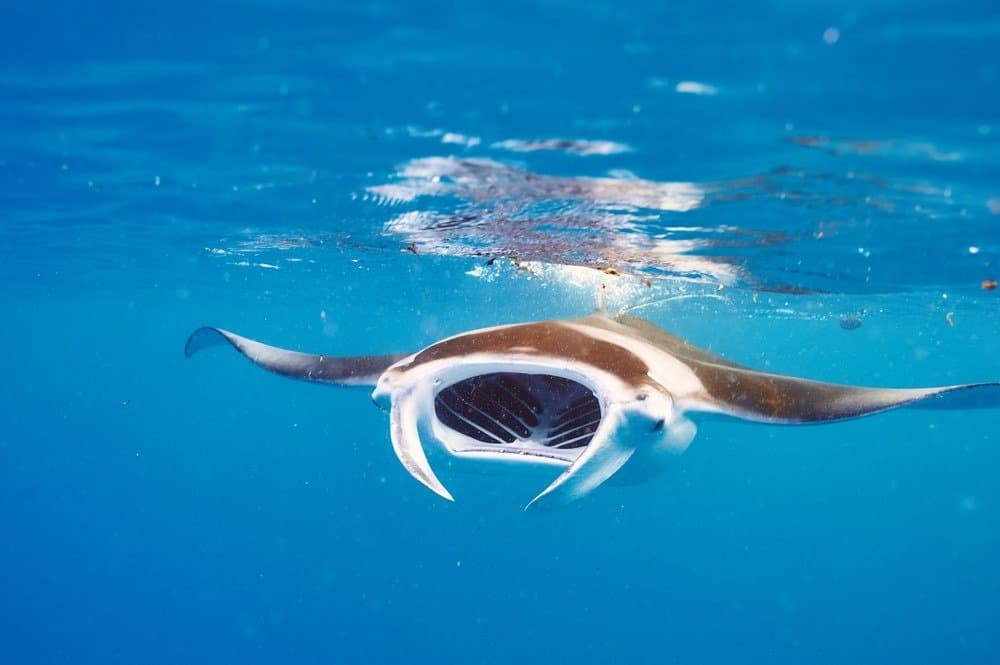
haveseen/Shutterstock.com
Eagle rays are majorly bottom feeders, eating oysters, snails, scallops, lobsters, worms, slugs, and hermit crabs, among other mollusks and crustaceans. They just eat the meat, leaving behind heaps of shattered shells. Thanks to the shape of their heads, they can dig up food concealed beneath the sand with their bodies acting like shovels.
Manta rays are filter feeders with forward-facing mouths that eat fish larvae and zooplanktons such as jellyfish, krill, shrimp, and conger eel. They have cephalic fins that protrude straight out from their body, almost like horns, to assist them in guiding their food into their mouths while eating.
Eagle Ray vs Manta Ray: Lifespan
The longevity of spotted eagle rays and many other species of this fish is estimated to be around 25 years, whereas the manta ray can live up to 40 years.
More from A-Z Animals
.more-snake-card-image { max-height:140px !important; }
@media (min-width: 481px) {
.mobile-top-content {
display: none;
}
}
#mobileTopContentCTACarouselControls { overflow: hidden; text-overflow: ellipsis; white-space: nowrap; }
.mobile-top-content .more { color: #fff; }
.mobile-top-content a { color: #fff; text-decoration: underline; }
.mobile-top-content a:hover { color: #fff; text-decoration: underline; }
@media (max-width: 480px) {
.mobile-top-content {
background-color: #06a10b;
color: #fff;
text-align: center;
/*height: 60px;
padding-top:5px;*/
font-size:80%;
/* display: block; */
margin: 0px -30px;
}
}
The eagle ray and manta ray are two of the most amazing aquatic creatures on the planet. They are a family of cartilaginous fish belonging to the Myliobatidae and Mobulidae families that live in the open ocean rather than on the seafloor.
About 12 species of flat, disk-shaped fish with wing-like pectoral fins make up the eagle ray family. These fishes live in warm tropical and temperate ocean and sea waters and have a widespread distribution. However, the manta Ray has had to deal with some genus changes. This species was originally classified as a part of the Manta genus and had the scientific name Manta birostris. Subsequently, Manta birostris and the reef manta ray, Manta alfredi, were both transferred to the Mobula genus because they are strongly linked to Mobula species.
It might be difficult to distinguish amongst the roughly 600 species of rays that exist. They have flat disk-shaped bodies and a long whip-like tail. These species also have mouths and gills on their stomachs and eyes on the tops of their heads. They can’t see their prey, so they rely on scent and electro-receptors like sharks.
Comparing the Eagle Ray vs the Manta Ray

A-Z-Animals.com
| Eagle Ray | Manta Ray | |
|---|---|---|
| Appearance | Disk-like shape, a long tail, and massive pectoral fins connected to their heads that resemble wings. | Large heads and triangular pectoral fins. Gill holes on their ventral surfaces and horn-shaped cephalic fins on both sides of the mouth. |
| Size | Length: Typically between 1.6 and 16.7 feet long, with wings up to 8 feet broad and a tail that can be up to 16 feet long. Weight: About 500 pounds. |
Length: Oceanic manta rays are usually about 13 feet but can reach 22 feet. Reef manta rays are generally about 10 feet. Weight: May weigh up to 4500 pounds. |
| Habitat | It can be found in warm coastal areas and estuaries throughout New Zealand and the Southwest Pacific. | Reef mantas can be found in shallow waters and coral reefs in moderate to tropical environments. Oceanic mantas live in warm tropical waters. |
| Diet | Majorly bottom feeders that eat oysters, snails, scallops, lobsters, worms, slugs, and hermit crabs, among other mollusks and crustaceans. | Filter feeders with forward-facing mouths that eat fish larvae and zooplanktons such as jellyfish, krill, shrimp, and conger eel. |
| Lifespan | Around 25 years. | Can live up to 40 years. |
The Key Differences Between Eagle Rays and Manta Rays
The key differences between eagle rays and manta rays are appearance, size, habitat, diet, and lifespan.
Let’s explore these differences in detail!
Eagle Ray vs Manta Ray: Appearance

Andrea Izzotti/Shutterstock.com
All eagle rays have a disk-like shape, a long tail, and massive pectoral fins connected to their heads that resemble wings. The mouth and gill openings are on the ventral (lower) side, while the eyes, fins, and tail are on the dorsal (top) side. The barb on the base of the tail behind the pelvic fins is essentially a venomous stinger. Eagle rays can be black, blue, and dark grey.
On the other hand, manta rays have large heads and triangular pectoral fins. They also have gill holes on their ventral surfaces and horn-shaped cephalic fins on both sides of their mouth. Their bodies are horizontally flattened, and their eyes are located on the sides of their heads, behind the cephalic fins. They have no skeletal support, and their tails are shorter than their disc-like bodies. The dorsal fins are small and positioned near the tail’s tip.
Eagle Ray vs Manta Ray: Size

Martin Prochazkacz/Shutterstock.com
Spotted eagle rays can grow up to 16.4 feet in length and have a 10-foot wingspan. The disk’s tail measures 2.5 to 3 times its width. Other eagle rays can grow between 1.6 and 16.7 feet long, with wings up to 8 feet wide and a tail that can be up to 16 feet long. The weight of the animal is estimated to be around 500 pounds.
A fully mature oceanic manta ray’s wingspan can reach 22 feet from tip to tip of each wing, but most are 13 feet long. They are the largest ray species in the world. Reef manta rays are typically about 9 to 11 feet long, though lengths of up to 16 feet have been observed in the past. Manta rays can be up to 4,500 pounds in weight.
Eagle Ray vs Manta Ray: Habitat
Eagle rays can be found in coastal areas and estuaries throughout New Zealand and the Southwest Pacific, where they spend most of their time in shallow waters up to 160 m deep. They are mainly found in warm coastal areas, searching for food on the ocean floor. When they’re not hunting on the ocean floor, they’re typically seen drifting through the water column. They spend most of their time on sandy and swampy grounds, but they can also be found near reefs.
Meanwhile, manta rays spend their entire lives swimming up and down the ocean’s column. Reef manta rays can be found in shallow waters and coral reefs in moderate to tropical environments. Oceanic manta rays, however, live in warm tropical waters all over the planet, spending the greater part of their lives between the surface and 400 feet deep.
Eagle Ray vs Manta Ray: Diet

haveseen/Shutterstock.com
Eagle rays are majorly bottom feeders, eating oysters, snails, scallops, lobsters, worms, slugs, and hermit crabs, among other mollusks and crustaceans. They just eat the meat, leaving behind heaps of shattered shells. Thanks to the shape of their heads, they can dig up food concealed beneath the sand with their bodies acting like shovels.
Manta rays are filter feeders with forward-facing mouths that eat fish larvae and zooplanktons such as jellyfish, krill, shrimp, and conger eel. They have cephalic fins that protrude straight out from their body, almost like horns, to assist them in guiding their food into their mouths while eating.
Eagle Ray vs Manta Ray: Lifespan
The longevity of spotted eagle rays and many other species of this fish is estimated to be around 25 years, whereas the manta ray can live up to 40 years.



